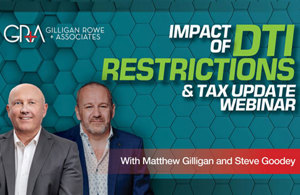
This week the Reserve Bank of New Zealand (RBNZ) announced their proposal to introduce debt-to-income (DTI) restrictions (also known as debt serviceability restrictions or DSRs) on home lending.
Being in practice as chartered accounts specialising in property, GRA are in a good position to read sentiment around the proposed rules based on feedback and observation from clients. At first glance, I thought the proposal wasn’t too bad. But after thinking about it and talking to clients, the ramifications may well be worse than many of us initially thought. A lot of people are on the edge of their servicing ability, and DTIs can only make it harder for them.
What are the proposed DTI rules?
Subject to feedback from the consultation process, which is currently underway, the plan is to initially set banks’ DTI restrictions as follows:
- 20% of residential property lending to owner-occupiers with a DTI ratio greater than 6 (i.e. the loan value can be more than 6 times the borrower’s income). In other words, 80% of the bank’s lending must be to owner-occupiers with a DTI ratio of less than 6 (i.e. the value of the debt is less than 6 times the borrower’s income).
- 20% of residential property lending to investors with a DTI ratio greater than 7, i.e. 80% of investor borrowers will need DTIs of less than 7.
To borrow new debt, you will divide your total home debt by six, and total investment debt by seven. Add these two numbers together. The resulting amount is the income you need to earn to meet DTI criteria. Existing debt only gets tested as part of approval of new debt, not for refinancing (per the exemption).
Example
Including your new loans you need:
• $700k of investment debt. You need $100k of income for DTI testing.
• $600k of home debt. You need another $100k of income.
• For the combined $1.3m, you need $200k of income for DTI testing.
Additionally, you still need to pass bank servicing tests to meet their prudential lending requirements.
The banks may scale your income down based on perceived risk or costs. For example, they may take 70 to 90 per cent of rents to allow for operating expenses. For self-employed income, they may take a percentage off. The banks are still working through how this scaling will work.
At the same time, the RBNZ proposes to ease the LVR restrictions to:
- 20% of owner-occupier lending to borrowers with an LVR greater than 80%
- 5% of investor lending to borrowers with an LVR greater than 70%
DTI exemptions
There are some exemptions to the proposed DTI restrictions. These include:
- Old lending, i.e. DTIs will not apply to refinancing of existing loans; they will only apply to new lending. This is good because as the recession bites, many borrowers’ incomes are falling, meaning they wouldn’t be able to re-qualify under the DTI rules (even though they are able to make their loan repayments and qualified under the old servicing requirements).
- Construction loans and loans for new builds. This is an important exemption, as without it supply of new housing would be restricted. If demand crashes due to borrowers not being able to qualify for loans, the supply side would also grind to a halt (developers won’t build houses if people are unable to buy them).
- Bridging finance
- Kainga Ora First Home Loan scheme
- Business loans
- Commercial property
What impact will DTIs have?
While the proposed DTI ratios appear to be roughly similar to the amount of servicing required under current bank testing, the hurt will come from the restricted bank discretion on how many people are allowed to ‘push the envelope’ and exceed the ratio. In particular, DTIs will make it much harder than it already is for people to get started (first home buyers and new investors).
At present the banks can look at the character of someone and give them the benefit of the doubt. For example, a young professional with a good job, a double-income household and no kids, is a good bet for a banker to back over time. But now this discretion and ability to help such people is being interfered with; only 20% of lending can exceed the ratio, and in practice the banks will seek to stay well under that. The main banks have proven to be responsible in their lending practices – why do we need to shut down their discretion that helps younger people get going?
Having said this, the majority of people (those who are not first home buyers or investors) will not be particularly affected by DTIs. They will have servicing capacity to just buy a house. But many new homeowners and investors have to push their limits - DTIs will curtail them, unless they are buying new builds (which are exempt).
Capital growth linked to income growth
In the long run, if DTIs are implemented it is logical that capital growth will be moderated by the link between income and the ability to borrow. Incomes will lag capital growth during boom times, so DTIs will inhibit bubbles from forming. And house price growth will become linked to long-term income growth, which is sobering for investors and homeowners. Socially this may well be quite progressive, but it will take the shine off growth and potentially cause reduced investment into the sector over the longer term.
So in a nutshell, I don’t think there will be a crash due to DTIs, because the exemptions are well thought through. But there must be reduced housing activity, and significant pain for people with stretched servicing.
DTIs and dropping interest rates
Currently the RBNZ is reluctant to drop interest rates for fear of causing house price inflation. DTIs will be a useful mechanism for them in this respect because they will be able to drop interest rates, but stifle inflationary investment with DTI settings. The Official Cash Rate (OCR) is a relatively blunt instrument, but with DTIs the RBNZ will be able to increase household liquidity through a lower OCR, while constraining borrowing. This could make them more inclined to drop interest rates in the future.
Do we need DTIs as well as LVR restrictions?
Arguably, LVRs are a back door DTI because they restrict debt (and therefore servicing requirements). LVRs also serve to constrain house price inflation.
I think the RBNZ should leave prudential lending policy as it is (under bank discretion), which is working very well in New Zealand. Don’t interfere with things that aren’t broken – we don’t need more red tape and nanny state interference. Leave it to the adults running the banks; they protect shareholder funds, and manage risk by lending at prudent levels (based on bank analysis). NZ history shows that the first tier banks do a good job at managing their risk (at least over the last 30 years). New Zealand banking is already well-managed and stable – our bank defaults are at globally envious (low) rates, so why are DTIs required at all? Certainly not to protect the stability of the banking system. Is this social policy in drag? They are just not needed.
As Chris Trotter said in his article on interest.co.nz, this type of regulation is reminiscent of ‘Muldoonism’ and the pre-1989 approach to bank regulation – blunt, cumbersome, and inflexible – with all the adverse impacts and economic and financial distortions to which such an approach can give rise.
In fact after the 2022 submissions, the RBNZ itself noted "the banking industry, property investor groups and the independent economist generally did not favour introducing DSRs, arguing that existing regulations are sufficient and that DSRs could have unintended negative consequences..."
Micro-management of bank lending decisions should have no place in a well-functioning market economy and financial system. Indeed, given that the RBNZ demonstrably lacks people with banking expertise and experience (including, remarkably, its senior management team), it is rather disturbing that they see themselves as being better qualified than bankers to assess the credit worthiness of borrowers.
In saying that, at least DTIs would stop the Reserve Bank from creating housing bubbles again. It is ironic that the only real house price bubble and correction of over 20% that I have seen in my career in New Zealand was caused by rules set by the current RBNZ governor, Adrain Orr, who has seriously over-driven the market. Between 2020 and 2022 first home buyers and new investors were lured into the property market at historically (and unnecessarily) low interest rates and high LVRs. This was done under an arguably panicked mantra of “Covid!”. After slamming rates to historic lows and keeping them there for too long, Orr then pulled the rug out from under the housing market, as he realised his inflationary mistake. He pushed interest rates too high (more than threefold) to supress the resulting demand and yanked back LVRs. And he has arguably kept interest rates too high for too long.
Yet now the same Reserve Bank governor who caused this volatility and harm to low equity / low income investors is telling banks how to run their books and stabilise banking with DTIs. Actually, Orr is the source of instability; he needs to do less, not more. He is over-reaching.
I would argue we don’t need DTIs; we need a more tempered RBNZ governor who does not over-drive the market, who controls volatility instead of creating it. Who is focused more on inflation, and less on social policy and climate change.
If DTIs have to come in at all, it would be far better to introduce them when we don’t have a recession looming.
What can you do to prepare?
If you think you are on the edge of your servicing limits and might need more funding, refinance early before DTIs arrive. You could also consider non-bank lenders, as they won't be subject to these rules. Talk to your brokers and bankers now to avoid getting caught out. Our mortgage supplier KPM Mortgages are very familiar with DTIs, as well as non-bank lending. You can contact them for a meeting here.
Summary
For many people, DTIs will not have much impact. But for those affected, the impact will be harsh and unnecessary. DTIs will slow capital growth over the long term, and housing supply may be stifled through the diminished ability to borrow for housing generally.
While I don’t believe DTIs are required, and I see them as another example of our Reserve Bank governor overdriving the market, the DTI proposal itself doesn’t look too bad and seems to be reasonably well thought through. It’s good to see a different ratio distinguishing investors from homeowners, and the exemptions listed above, including new builds and existing loans.
We expect activation dates and initial DTI settings to be announced around the middle of this year, and it will be interesting to see if much of the proposal changes after consultation feedback is considered. I would also table it is possible that the government reject DTIs; they are not a done deal. We will keep you updated (at www.gra.co.nz) as information comes to hand.

Matthew Gilligan
Managing Director and Property Services Partner
Did you like this article? Subscribe to our newsletter to receive tips, updates and useful information to help you protect your assets and grow your net worth. We're expert accountants providing expert advice to clients in NZ and around the world.
Disclaimer: This article is intended to provide only a summary of the issues associated with the topics covered. It does not purport to be comprehensive nor to provide specific advice. No person should act in reliance on any statement contained within this article without first obtaining specific professional advice. If you require any further information or advice on any matter covered within this article, please contact the author.
Comments
Testimonials
Hi Juliette, Just want to say thank you for all the work you have done and advice you've given. Definitely tricky during these Covid times and still getting the job done. Want to wish you and your team good fortune, and hopefully in the future work together to get another property.
- Arthur W, September 2021
Property 101by Matthew Gilligan
Investing in residential property?
Put this at the top of your reading list.
If you're investing in residential property, seeking to maximise your ability to succeed and minimise risk, then this is a 'must read'.
Matthew Gilligan provides a fresh look at residential property investment from an experienced investor’s viewpoint. Written in easy to understand language and including many case studies, Matthew explains the ins and outs of successful property investment.
- How to find the right property
- How to negotiate successfully
- Renovation do's & don'ts
- Property management
- Case studies and examples
- and much, much more...








































